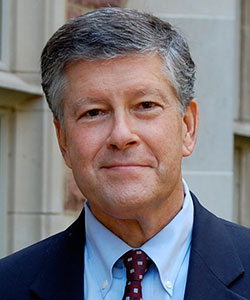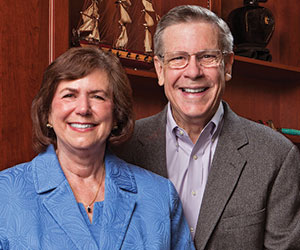Academic Observer
Launching an Education Revolution

Henry L. Roediger, III
The Academic Observer is an occasional column by APS Past President and Publications Committee Chair Henry L. Roediger, III, who is James S. McDonnell Professor at Washington University in St. Louis.
AO: What inspired you to pursue the Noba project? Why now?
E&CD: We believe a revolution in college education is possible, making it both more effective and less expensive. This revolution will involve electronics and the Internet, as well as more active forms of learning for students. We want to be part of that revolution, and believe that our website (nobaproject.com) and award programs will spur innovation.
Several things worried us about traditional textbooks. We have a lot of close friends who are textbook authors, and so we have seen the process up close. One problem is that authors are pushed to frequently update their books. New editions mean that students cannot buy used texts and must buy the newer expensive ones. This becomes so costly that many students share textbooks or simply do not buy the text. It is shocking how many students do not purchase the needed textbooks. We were especially worried about poor students here at home and students in less developed nations overseas. We want college education to reach everyone around the globe, but textbook prices represent an obstacle to this.
Also, most professors do not use the entire textbook. There is simply too much in most textbooks for the average student to really read and master. Our electronic chapters have the great advantage that professors can select the chapters they want, and put them in the order they want.

Ed and Carol Diener
One thing that motivated us to create Noba was that we believe psychology education needs to be more active — students need to think about, use, and elaborate the material, and not simply memorize it for a multiple-choice test. Together we have taught psychology for 60 years, and our impression is that most students currently do not learn the material in a way that will ensure that they can use it in life and remember it for the long-term. We envisioned that our website readings could be linked to learning aids, exercises, games, and other material that would help students truly master the material. Thus, step one was to produce readings, but step two is to produce active learning materials to accompany the chapters.
AO: What does Noba stand for? Where did the name come from?
E&CD: Noba is not an acronym. We wanted a name that was simple, had roots in Latin, and was evocative of the newness that we think Noba embodies.
Ed Diener has conducted research on subjective well-being for the last three decades, with over 81,000 citations of his work. He has been the editor of three journals and the president of three scientific societies. Diener was awarded the Distinguished Scientist Award of APA, the APS William James Fellow Award for lifetime achievement in research, the Distinguished Scientist Award of the International Society for Quality of Life Studies, and several honorary doctorates. His research focuses on the causes and consequences of subjective well-being.
Carol Diener is an award winning teacher, now retired, from the University of Illinois. She is the former director of the Mental Health Worker program and created three community outreach programs involving both graduate and undergraduate students.
Read more about the Noba project in the Observer.
AO: What do you see as the advantages of online texts? Why would a professor choose your e-text?
E&CD: There are quite a few reasons we decided to do an online text. First, of course, is that our books are free, and the digital format is helpful in this. Students could — collectively — save millions of dollars a year if professors select our textbooks. Second, we can more easily update chapters that need updating, rather than automatically revising our entire book every 2 years so that students must buy the new edition. Third, our book allows links to other material on the web to be made quickly and easily. Fourth, students love digital, and our book is easy and convenient. You can read our chapters on your smart phone, tablet, personal computer, and wherever you are at the moment (although not while driving, we hope). Fifth, our chapters are authored by experts in each field, and so they can be more accurate and more up to date. The experts know what is important in their fields and what is not. It is very difficult for one or a few generalists to be completely accurate, up to date, and wise about what to present across all areas of psychology. Sixth, professors can choose exactly what material, and in what order, they want to assign. Seventh, we can respond quickly to feedback and adjust materials to better fit the needs of users. Eighth, digital is more environmentally friendly. Finally, our website will allow presentation of all sorts of active learning aids as we develop them.
AO: Do you have experience with students using the texts yet? What is their reaction?
E&CD: We have just launched Noba. Already we have several thousand users. Our materials are being used for extra credit, for supplementary reading, and as primary texts. Student users are able to provide feedback to us with regards to chapter length, interest, and engagement. Across all our chapters we receive a rating of 4.24 out of 5 for overall interest and engagement. In any case that we find lower scores, we can return to the source material and improve it.
AO: Online textbooks provide the opportunity for all sorts of fancy animations, links, and figures, yet the books you have created so far use these features quite sparsely. What prompted you to decide on this tactic? Why not make the chapters flashier, with links to figures and videoclips, etc.?
E&CD: Standard textbooks try to jazz up material by including cartoons and covering other light subject matter. This may or may not be effective for learning, but we wanted to hear back directly from our students and professors before assuming they want these materials. We initially decided to pare down “fluff” material to have shorter chapters, and our user feedback seems to indicate that this was a good choice.
Without using them as a gimmick, we are adding more illustrations, where needed, and links to more video content. Our emphasis is on active learning rather than passive illustrations. Our first effort in this area is the Noba Video Awards. We are awarding thousands of dollars to students who make engaging videos related to learning and memory concepts. We feel that inviting students to create videos is, itself, a more involved approach to learning. You can see more about the awards on the Noba website.
AO: Many authors have spent years of their lives working on textbooks, and companies have invested large sums in having these texts reviewed and marketed. Your books undercut the traditional textbook market as an extremely disruptive technology. Does this worry you?
E&CD: One thing that worries us is the huge amount book companies spend on their books to make the presentations showier — cartoons, illustrations, and so on. They also spend a lot on additional resources for instructors, such as test banks. Finally, they spend a lot marketing their books — sending representatives around to personally talk to professors, and so forth. These factors make textbooks extremely expensive — often in the $150 to $200 range. Our worry is that the professors’ choice of textbooks is not sensitive to price because someone else, the students, is picking up the bill. Economists use textbooks as a classic example of where market forces do not determine the price. We know that if students were to select, then a free or very inexpensive text would be chosen almost every time. But with professors choosing, price is really secondary. If professors had to pay for the texts themselves, it would be a different matter.
We think that paper textbooks are buggy-whip technology. Computers and the Internet are here to stay. An important question is whether small fry “Davids” can make headway against the “Goliath” textbook publishers, who will enter this electronic market more and more. Everyone talks about how expensive college education is, but we are trying to do something about it. We might feel some pushback from publishers, but we are hoping to see them moving more toward engaged learning, digital formats, and less expensive products.
AO: “Free” is a tough business model to perpetuate. How can free textbooks be sustainable over the long term? (Will you have pop-up ads?)
E&CD: In order to become permanent, our model for textbooks, ancillary readings, and learning aids must have a way to support itself monetarily. Right now our charitable foundation is doing that, but in the long run we need to provide a broader source of funding. We are currently developing a long-term strategy for funding. This might include grants, strategic partnerships, and user-based donations such as those that fund Wikipedia and public radio. We are currently approaching foundations as our first effort to obtain additional funding beyond what we are providing. You won’t be seeing pop-up ads anytime soon on Noba!
AO: Is Noba created for the long haul or do you see this project running a finite amount of time, say 15 years? Or is it too early to say?
E&CD: We would love for Noba to become a perpetual and broad educational resource. We personally won’t last that long, and our support cannot hold out for that long. This is why we are hoping that the movement becomes broad, and that lots of people become involved in the future. Professors and students can help us revolutionize education.





APS regularly opens certain online articles for discussion on our website. Effective February 2021, you must be a logged-in APS member to post comments. By posting a comment, you agree to our Community Guidelines and the display of your profile information, including your name and affiliation. Any opinions, findings, conclusions, or recommendations present in article comments are those of the writers and do not necessarily reflect the views of APS or the article’s author. For more information, please see our Community Guidelines.
Please login with your APS account to comment.